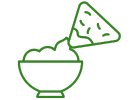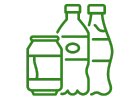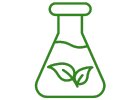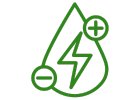Sodium percarbonate + 3% TAED přírodní bělící přípravek pro praní i úklid - 3 kg, 5 kg
Sodium percarbonate + 3% TAED from the Czech manufacturer Qualt Rakovník is a great choice for a natural way to clean the home without toxic cleaning and detergents. It is a versatile and useful household helper.
It is also known for its whitening effects, making it an ideal and effective partner in removing all kinds of stains and dirt. It's great to team up with the top eco detergent from Japan, which is magnesium-based, TerraWash+Mg. We are the exclusive importers of this invention in the Czech Republic. We have been using it ourselves for laundry for many years. Combined with percarbonate, it's a game changer in laundry:
We also recommend combining it with Almawin detergents, whether it is a detergent for coloured laundry or for white and coloured laundry.
In addition, we also offer it with the scent of lavender. Thanks to this combination, you can say goodbye to all the stains on your clothes, and you can count on beautifully washed and fragrant laundry.
Benefits
- Its composition is also very beneficial in removing other impurities such as grass, blood.
- Suitable for all types of washing machines, even for hand washing.
- You can also use it to clean your bathroom - your bathtub and sink have never been whiter.
- Great for removing odours from drains and toilets.
- Suitable for all surfaces.
- Environmentally friendly and very effective, it works even at washing temperatures from 30 °C.
Usage and Dosage
- For coloured linen, use only if it is colorfast.
- For colorfast laundry 1 tablespoon to washing powder.
- For white laundry up to 3 tablespoons to the washing powder.
Ingredients
970 g sodium percarbonate and 30 g TAED activator.
Sodium percarbonate
Chemically, sodium percarbonate is used as an alternative to hydrogen peroxide. The chemical formula of sodium percarbonate is C2H6Na4O12.
The preparation of sodium percarbonate consists of the gradual introduction of sodium peroxide into extremely cold pure alcohol. In a relatively short time, sodium percarbonate dissolves in water and sodium carbonate peroxide and hydrogen peroxide are released into the solution. The decomposition of percarbonate can be carried out with a small amount of moisture in the atmosphere.
What is TAED
TAED(Tetraacetylethylenediamine) is a bleach activator that reacts with hydrogen peroxide sources such as sodium percarbonate to produce peracetic acid, which is great at removing oxidizable stains such as coffee, tea or red wine.
What is sodium percarbonate
Sodium percarbonate combines two compounds, hydrogen peroxide and sodium carbonate. Other names for it are sodium peroxycarbonate and oxyper. The chemical formula of percarbonate indicates that pure sodium percarbonate contains 67,5 % sodium carbonate and 32,5 % hydrogen peroxide (by weight). It is a white crystalline powder called sodium percarbonate.
It is most commonly used as a bleaching agent in detergents, laundry additives and automatic dishwasher products. Consumers can also purchase 100% pure product as a laundry ingredient. In addition, percarbonate can contain dental, multipurpose and drain cleaners. Sodium percarbonate dissolves rapidly in water and decomposes into sodium carbonate peroxide and percarbonate hydrogen peroxide.
Process for the production of sodium percarbonate
Worldwide, sodium percarbonate is produced in 10 to 15 production plants, about half of which are located in Europe. It is produced by combining sodium carbonate and hydrogen peroxide percarbonate by dry, spray or wet methods. In the dry process, solid sodium carbonate is sprayed with an aqueous solution of hydrogen peroxide, which reacts with the solid to form percarbonate.
In spraying, the fluid bed method is used to produce sodium percarbonate. By injecting solutions of hydrogen peroxide and sodium carbonate into the drying medium, the water is evaporated. It is often produced by a wet crystallisation process, perhaps in conjunction with desalination.
Use of sodium percarbonate: In the home
Although sodium percarbonate, also known as sodium carbonate peroxyhydrate, has a long and ominous sounding name, it is a useful, environmentally friendly material that can be used in a variety of household applications.
It is an excellent complement to laundry detergents and routine household cleaning. Because sodium percarbonate has a bleaching effect, stain removers often contain it.
The combination of the ingredients sodium carbonate and hydrogen peroxide produces sodium percarbonate, sometimes referred to as oxygen bleach. Sodium hydroxide dissolves in water and changes to water, oxygen, sodium carbonate or sodium carbonate.
Using sodium percarbonate throughout the house has several advantages, including the fact that it is easy to store and is relatively economical.
Because sodium percarbonate is a powder, it can easily be used to remove stains and marks or to form a paste or solution for other purposes.
Compared to some alternatives, sodium percarbonate is also significantly more environmentally friendly.
Laundry
Sodium percarbonate has a bleaching effect, making it useful as a cleaning solution or laundry aid. Many commercial stain removers already contain oxygen bleach, but you can also add percarbonate to your laundry by hand.
Bathroom
Sodium percarbonate can also help with this task. To clean and sterilize the bathroom, mix 2 teaspoons of sodium percarbonate with 500 ml of warm water. Continue stirring until the sodium percarbonate dissolves.
Leave for at least 30 to 60 minutes before cleaning the surfaces. If stains persist, leave the sodium percarbonate on overnight.
Tiles and grouts
Despite their location in the house, tiles and grout can easily turn black due to mould, fungi or just plain dirt. Sodium percarbonate can easily remove troublesome mold or mildew stains from tile or grout by forming a paste. Make a paste of sodium percarbonate and a little water, then apply it to the tiles with a fresh sponge or cloth.
Kitchen
Sodium percarbonate can perform some cleaning tasks in the kitchen as well as in the bathroom. It can disinfect, clean and remove odours, making it the best substitute for industrial chemicals.
Additional parameters
| Category: | Detergents |
|---|---|
| EAN: | — |
| Výrobce: | Qalt, Rakovník s.r.o., Zavídov 72, 27035, Petrovice |
| Země původu: | Česká Republika |
| Vhodné pro: | Citlivá pokožka |
Be the first who will post an article to this item!

Eco-friendly cleaning powders such as baking soda, citric acid and sodium percarbonate have historically been used for household cleaning due to their effective and non-toxic properties.
These natural substances are a safe alternative to conventional chemical cleaners, providing excellent results without negatively impacting the environment.
They also contribute to a clean and healthy home environment, are biodegradable and non-polluting, promoting sustainable living habits that build on a long tradition of using natural resources for cleaning.
What makes us unique?
- Environmental friendliness: These substances are biodegradable and do not leave toxic residues.
- Versatile use: from surface cleaning and stain removal to laundry bleaching and disinfection.
- Safety and non-toxicity: they do not contain aggressive chemicals and are non-toxic to humans and pets. They do not pose a health risk.
- Efficiency without compromise: Cleaning efficiency is comparable to conventional chemical agents.
-
Historically proven: they have been used for household cleaning for generations, proving their reliability and efficiency.
Benefits of organic powders
Baking Soda (Bicarbonate of Soda)
- Nature: It is biodegradable and leaves no toxic residue, making it an environmentally friendly choice.
- Home: Neutralises odours, removes stains and grease, making it a versatile cleaner for kitchens and bathrooms.
- Cleaning: the mildly abrasive properties allow gentle cleaning of surfaces without damaging them, making it ideal for glass, tile and stainless steel.


Baking soda (for use with vinegar)
- Nature: The combination of baking soda and vinegar creates a non-toxic mixture that breaks down into water and CO₂ when reacted, making it environmentally friendly.
- Home: Great for cleaning drains, loosening clogs and neutralising unpleasant odours in kitchens and bathrooms.
- Cleaning: the reaction of baking soda and vinegar helps remove grease stains and deposits, improving the overall cleanliness of surfaces.
Citric acid (as a plasticizer)
- Nature: It contains no synthetic substances and leaves no toxic residue after decomposition, making it environmentally friendly.
- Home: Naturally softens water, reducing the need for chemical softeners and improving the effectiveness of detergents.
- Cleaning: improves the effectiveness of cleaning products, helping to reduce the overall amount of chemicals needed while leaving surfaces clean and shiny.


Sodium percarbonate
- Nature: The combination of baking soda and vinegar creates a non-toxic mixture that breaks down into water and CO₂ when reacted, making it environmentally friendly.
- Home: Great for cleaning drains, loosening clogs and neutralising unpleasant odours in kitchens and bathrooms.
- Cleaning: the reaction of baking soda and vinegar helps remove grease stains and deposits, improving the overall cleanliness of surfaces.
Sodium percarbonate with TAED
- Nature: No harmful substances are produced during decomposition. Percarbonate decomposes into water, oxygen and sodium, while TAED is biodegradable, minimizing the negative impact on the environment and not burdening aquatic ecosystems.
- Household: TAED increases the effectiveness of percarbonate especially at low temperatures. This combination enables effective bleaching and stain removal even in cold water, saving energy and protecting fabrics from damage. In addition, it provides disinfecting effects that ensure cleaner and more hygienic washing.
- Cleaning: percarbonate with TAED produces peracetic acid, which is a strong oxidizing agent. It effectively removes organic stains, breaks down fats and proteins while disinfecting surfaces. Improves bleaching and cleaning efficiency and allows faster and more effective cleaning even at lower temperatures.


Tetraacetylethylenediamine (TAED)
- Nature: TAED is easily biodegradable and environmentally friendly. It activates bleach at lower temperatures, reducing energy consumption and stress on ecosystems.
- Home: Increases the effectiveness of sodium percarbonate, allowing for effective bleaching and disinfection at low temperatures. It saves energy and extends the life of textiles without the need to use aggressive chemicals.
- Cleaning: TAED activates percarbonate into a powerful oxidizing agent that effectively removes stains, breaks down organic matter and kills microorganisms. This ensures greater cleanliness and hygiene during cleaning.
Using these eco-friendly cleaning products not only promotes a healthier home environment, but also protects our planet from harmful chemicals.

.jpg)













































































